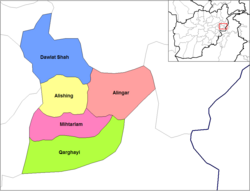Mihtarlam District is located in the center of Laghman Province of Afghanistan and consists of the urban centre and provincial capital Mihtarlam, 24 major villages and 269 sub-villages.
Mihtarlam District
مهترلام | |
|---|---|
 Location in Laghman Province | |
| Country | |
| Province | Laghman Province |
| District | Mihtarlam District |
| Capital | Mihtarlam |
| Elevation | 779 m (2,556 ft) |
| Population | |
| • Urban | 32,949 [1] |
| Time zone | UTC+4:30 (Afghanistan Standard Time) |
Etymology
editMihtarlam derives its name from Mihtarlam Baba (Lamech), who was reputed to be the father of the prophet Noah.[2]
Geography
editIt borders Kabul Province to the west, Alishing and Alingar districts to the north and Qarghayi District to the east and south.
Demographics
editThe district's population is 121,200 (as of 2006) - 60% Pashtun, 35% Tajik and 5% Pashai.[3] The city of Mehterlam has a population of 32,949.[1] It has 10 districts and a total land area of 1,397 hectares.[4] The total number of dwellings in this city is 3,661.[4]
Land use
editThe Alishang river pours into Alingar River just south of the district center, and the lands around them are irrigated. Agriculture is the main source of income. Many young men search for work in Iran and Pakistan. About 59% of the houses were partially or fully destroyed during the wars. Many people fled, but now they are returning.
Mihtarlam is located in eastern Afghanistan 40 km from Jalalabad and between two rivers: Alishang and Alingar. It is almost equally divided between built-up land (51%) and non built-up land (49%).[4] Residential land is largely clustered in Districts 1–3.[4] District 1 is also home to a large commercial and institutional area (50 ha).[4]
References
edit- ^ a b "The State of Afghan Cities report 2015". Archived from the original on 2015-10-31.
- ^ Ariana Antiqua, Wilson, pg. 97
- ^ . 2016-03-03 https://web.archive.org/web/20160303192917/http://www.aims.org.af/afg/dist_profiles/unhcr_district_profiles/eastern/laghman/mihtarlam.pdf. Archived from the original (PDF) on 2016-03-03. Retrieved 2020-10-09.
{{cite web}}: Missing or empty|title=(help) - ^ a b c d e "The State of Afghan Cities report 2015". Archived from the original on 2015-10-31. Retrieved 2015-10-22.
External links
edit34°38′44″N 70°10′53″E / 34.6456°N 70.1814°E